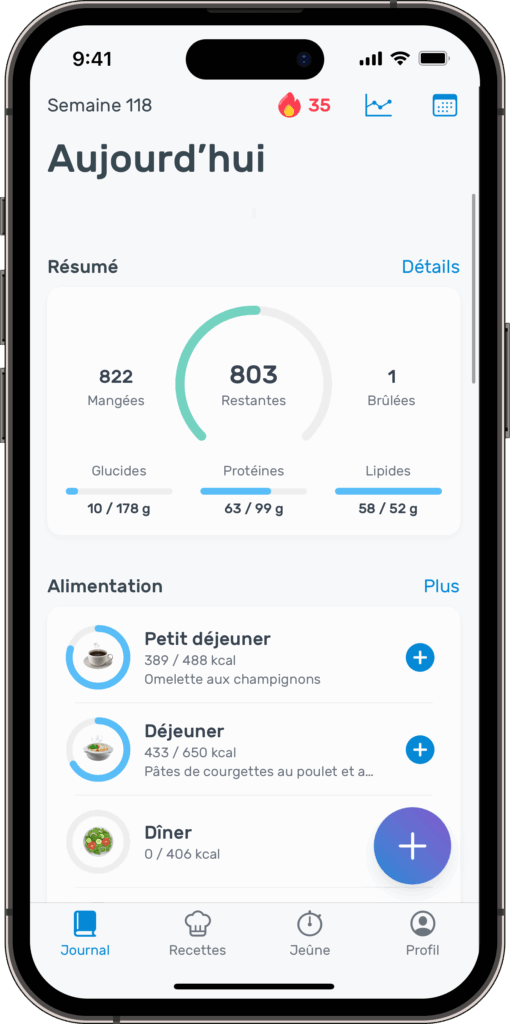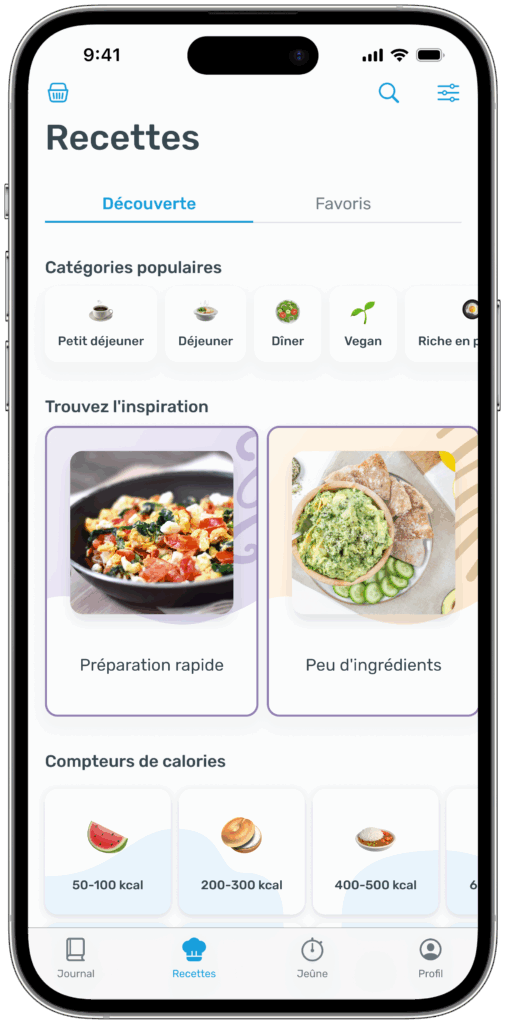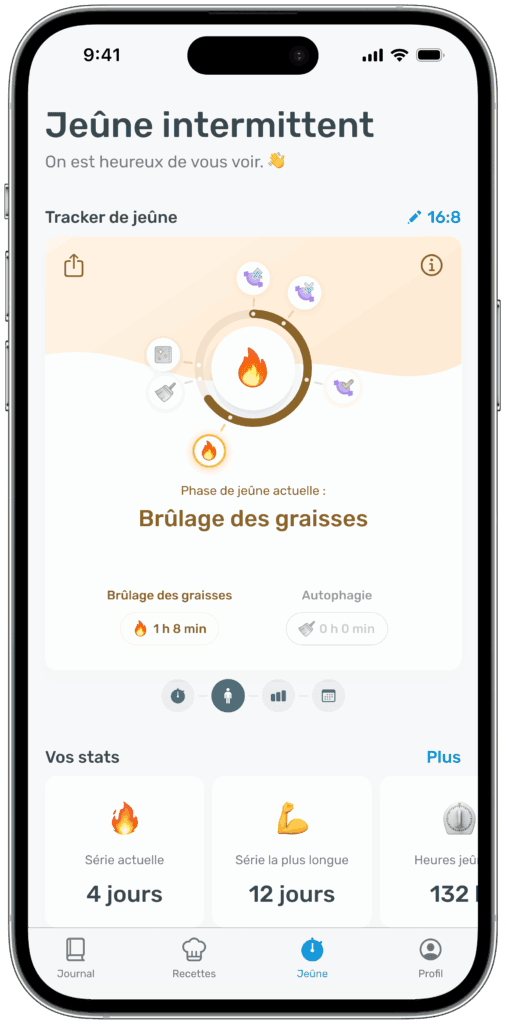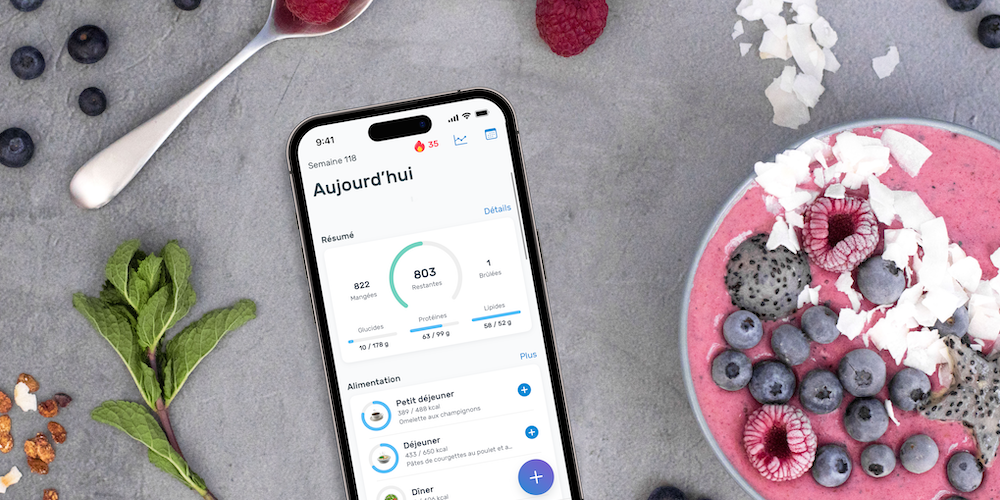Sponsored article
Sebastian Weber and Florian Weissenstein, two friends passionate about fitness and technology, first designed YAZIO for a university project in Germany, before launching the app in 2014.
Today, this nutrition-tracking app has more than 100 million users.
It has been translated into 20 languages, is used in 150 countries, and has a database including more than 2,700 recipes: an impressive growth.
I’ll explain here how it works and share with you my opinion as a dietitian.
👉 Cliquez ici pour découvrir YAZIO
My YAZIO test
Exploring the PRO version
Not being a frequent user of nutrition-tracking apps, I was curious to try YAZIO in its PRO version.
Upon signing up, the app guides me step by step, asking me to first enter some information (age, sex, weight, height, activity level…) to determine my basal metabolic rate.
I had briefly tried apps like MyFitnessPal, but I find that YAZIO stands out for its clean interface and clear charts.
Setting a personalized goal
YAZIO then offers 4 main goals to choose from :
- lose weight
- gain weight
- stabilize weight
- build muscle
The app offers 4 different dietary approaches :
- the YAZIO diet (balanced)
- low-carb
- high-protein
- low in fat (which should be called low in fats to be dietetically accurate)
I opt for the YAZIO diet and my goal is to lose two kilograms, at a rate of 1 kg per week.
In a few clicks, the algorithm automatically generates my daily calorie intake, based on the Mifflin-St Jeor formula, a scientifically recognized method for estimating basal metabolic rate (BMR).
YAZIO then applies a physical activity factor (NAP), then adjusts the whole calculation according to the chosen goal (weight loss, maintenance, or weight gain).
In my case — weight loss — the app automatically applied a deficit of 750 calories per day, which corresponds to an estimated loss of 1 kg per week, the maximum allowed.
Result: I should consume 1062 calories per day, split between 45% carbohydrates, 25% protein, and 30% fat.
The basic calculation is consistent. However, I find this deficit a little large because an average deficit of 600 calories per day is recommended to promote healthy weight loss.
The food diary and notifications
The core of YAZIO is truly its food diary. Every day, I log my meals using the search bar or the barcode scanner, handy for packaged products.
I really like the visibility of the remaining daily calories as meals progress.
This helps me identify if I’m lacking protein or fiber, for example, and to better adjust my choice of foods going forward.
YAZIO also includes a hydration plan with regular reminders to drink. My personal goal is set at 2 liters per day.
Without being overwhelmed, I receive notifications and messages that motivate me. Honestly, this has helped me stay consistent, because I can easily forget to log certain foods.
After a few days, I check nutrition statistics and averages and adjust my habits for the rest of the week.



My review of YAZIO
The advantages of the app
Whether it’s signing up or adding foods, everything is designed to be fast and user-friendly. The interface is quite intuitive.
I think its educational side, personalization, and ease of use can make it an ally for healthier eating.
L’application permet de connaître la répartition des macro et micro-nutriments, l’eau et les calories consommées. Je trouve que cela favorise une meilleure prise de conscience nutritionnelle.
I liked the many recipes, very well organized, to choose according to your dietary preferences and nutritional goal. I recommend the Brazilian coconut bites!
The ability to adapt your plan and change your goals along the way is also an asset. I was able to easily switch from the YAZIO diet to the high-protein diet.
Finally, I find the synchronization with other apps like Apple Health and Fitbit very useful. It’s very convenient for easily estimating energy expenditure.
I could recommend this app to my clients, either to reassure them, or to help with stabilization.
Limitations and precautions to take
I tested the PRO version myself, but I should point out that the app remains limited in its free version, with no access to meal plans or advanced analyses.
Nutritional recommendations, while convenient, do not replace personalized follow-up by a healthcare professional.
Furthermore, the food evaluations can sometimes lead to an overestimation or an underestimation of intake. I was surprised to find that half an avocado could provide either 560 calories or 165 calories, for example.
Finally, the app highlights the intermittent fasting, without specifying its benefits or contraindications and without my having previously selected this method.
The app may not be suitable for vulnerable individuals such as adolescents, pregnant women, or people with eating disorders.



